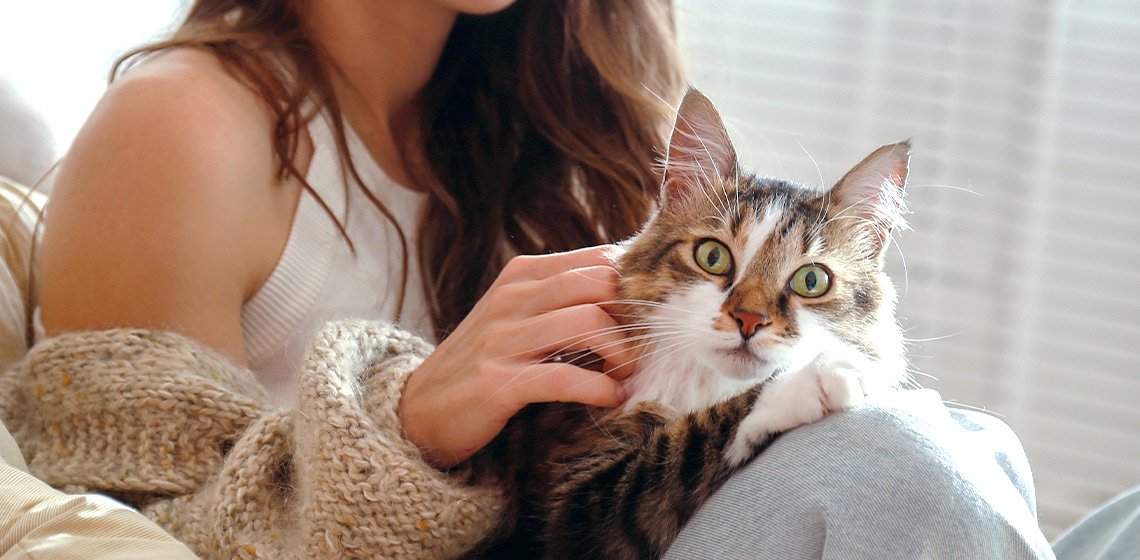There has been a flurry of activity on social media in recent times regarding supposed ‘Down Syndrome cats’. This has led many pet parents with cats who show certain behaviors, or look a certain way, to question whether their cat has Down Syndrome.
The simple answer is no, cats cannot have Down Syndrome. It is a uniquely human condition. So, for those pet parents wondering if their cat has Down Syndrome, let’s explore what could actually be going on.
Can a cat have Down Syndrome?
The simple answer is no, feline Down Syndrome does not exist! To answer the question more fully, we need to look at what Down Syndrome is.
Humans are born with 23 pairs of chromosomes in each cell, so 46 in total. Chromosomes are found in the nucleus (center) of each cell, and they are made of a protein and DNA (deoxyribonucleic acid). DNA contains our unique genetic information.
In Downs Syndrome, babies are born with an extra copy of chromosome 21, which alters the way they develop. In the vast majority of cases, Down Syndrome is not an inherited condition, it happens by chance.
So, why can’t cats get Down Syndrome? Cats only have 19 pairs of chromosomes, so 38 in total. This means they don’t have chromosome 21, the one which people with Down Syndrome have an extra copy of. This makes it impossible for cats to have Down Syndrome.
Cats can (rarely) be born with an extra copy of a chromosome, but since it isn’t (and can’t be) chromosome 21, these cats do not have Down Syndrome.
The simple answer is no, feline Down Syndrome does not exist!
Cats with physical or behavioral abnormalities
So, what can cause physical or behavioral differences in cats? Physical and behavioral changes or abnormalities in cats can be caused by:
- Infection
- Neurological (affecting the nervous system) disease
- Trauma
- Congenital (present from birth) disorders
- Toxins
- Poor nutrition
- Individuality or uniqueness (no two cats are the same!)
There are also many inherited disorders in cats, which can cause a wide range of physical and behavioral symptoms. This list is not exhaustive, and there are a great number of conditions that can alter a cat’s appearance or behavior.
If you are at all concerned about the way your cat or kitten looks or behaves, then it’s really important you take them to your veterinarian for a physical exam as soon as possible. Cats tend to hide illness very well, so if they are showing any unusual symptoms then a veterinary exam is crucial.
If you are at all concerned about the way your cat or kitten looks or behaves, then it’s really important you take them to your veterinarian for a physical exam as soon as possible.
Common conditions causing physical or behavioral changes in cats
- Cerebellar hypoplasia
The cerebellum is the part of the brain responsible for coordinated movement, and hypoplasia means under-formation. So cerebellar hypoplasia is where the part of the brain in charge of coordinated movement doesn’t develop properly.
Symptoms of cerebellar hypoplasia include problems with balance, head tremors, ataxia (swaying), and a wide-based stance (meaning they stand with their legs wide apart). Kittens with this condition are often referred to as “wobbly kittens”.
If you suspect your kitten has cerebellar hypoplasia, you should take them to your veterinarian as soon as possible. Your veterinarian will need to rule out other conditions, which could involve a physical exam and some blood tests. They may advise a scan of your kitten’s brain.
- Panleukopenia infection
Panleukopenia virus, also known as feline parvovirus, causes a disease called Feline Infectious Enteritis (FIE). It is a highly contagious and very serious disease, which can be fatal. Fortunately, it’s one of the diseases we can vaccinate against.
Symptoms include sickness and diarrhea (which may contain blood), lack of appetite, fever, and lethargy. It also causes a decrease in white blood cells (leukopenia). If a pregnant cat or a kitten under 4 weeks of age becomes infected, this can cause the kitten to be born with or develop cerebellar hypoplasia.
If you aren’t sure if your cat or kitten is protected against this nasty disease, have a chat with your veterinary team today.
Cats experience stress remarkably easily. Any change in routine, environment, or members of the household can cause a cat to become stressed. Stress can cause a cat to display repetitive or unusual behaviors.
- Head trauma
Moderate to severe trauma to the head area at a young age may cause facial abnormalities due to scarring. Severe trauma can also result in neurological damage, which may present as behavioral abnormalities.
Symptoms could include a lack of coordination, ataxia (a wobbly walk), or unusual behavior. If the trauma happened at a very young age, these symptoms may seem to have been present from birth.
If you know or suspect that your cat has experienced a trauma to the head, it’s important to take them for a veterinary exam, even if they seem fine.
- Toxins
If a pregnant cat is exposed to certain drugs, chemicals (such as pesticides), or environmental toxins then the kitten can also be exposed while in the uterus (womb). This can cause the kitten to be born with congenital defects, such as cerebellar hypoplasia.
- Stress or anxiety
Cats experience stress remarkably easily. Any change in routine, environment, or members of the household can cause a cat to become stressed. Stress can cause a cat to display repetitive or unusual behaviors. Stress in cats can also have a significant effect on the cat’s health, causing problems with the urinary tract or skin, for example.
Conclusion
If your cat is showing any physical or behavioral abnormalities, or any unusual symptoms, you should schedule an appointment with your veterinarian as soon as possible. It’s important that you never try to self-diagnose. There may well be treatment available. If not a cure, then to relieve the symptoms. Your veterinary team will also be able to support you with any special or extra care that your cat may need.
FAQ
The simple answer is no, Down Syndrome cats do not exist. Cats have a different number of chromosomes from us, making it impossible for them to have Down Syndrome.
Cats can sometimes (rarely) be born with an extra chromosome. However, not the extra chromosome found in people with Down Syndrome, as cats don’t possess that chromosome.
An example in cats would be male cats with tortoiseshell coloring, which is usually unique to female cats. These male cats are very rare and possess an extra chromosome.

Sarah-Jane Molier wanted to be a veterinarian from around the age of ten. After much hard work, and her first degree in animal science, she realized this dream and graduated in 2009. She has been working in small animal clinics ever since.








